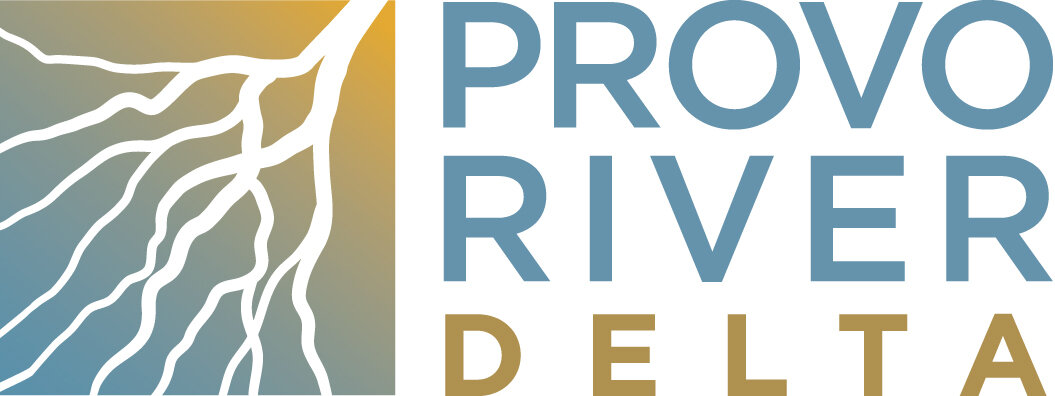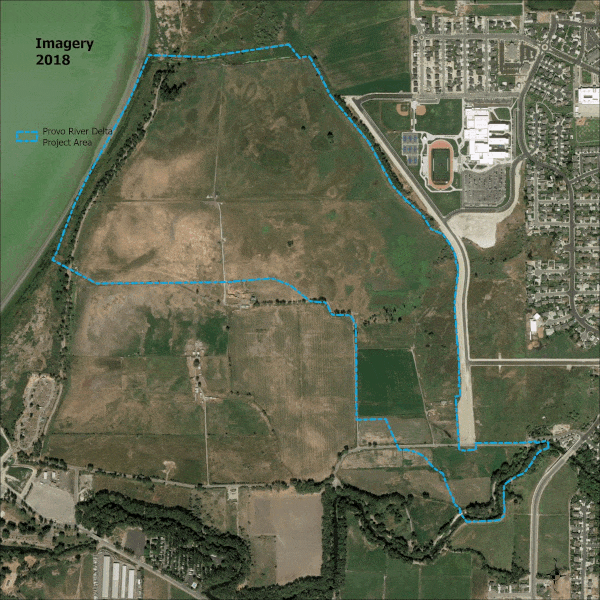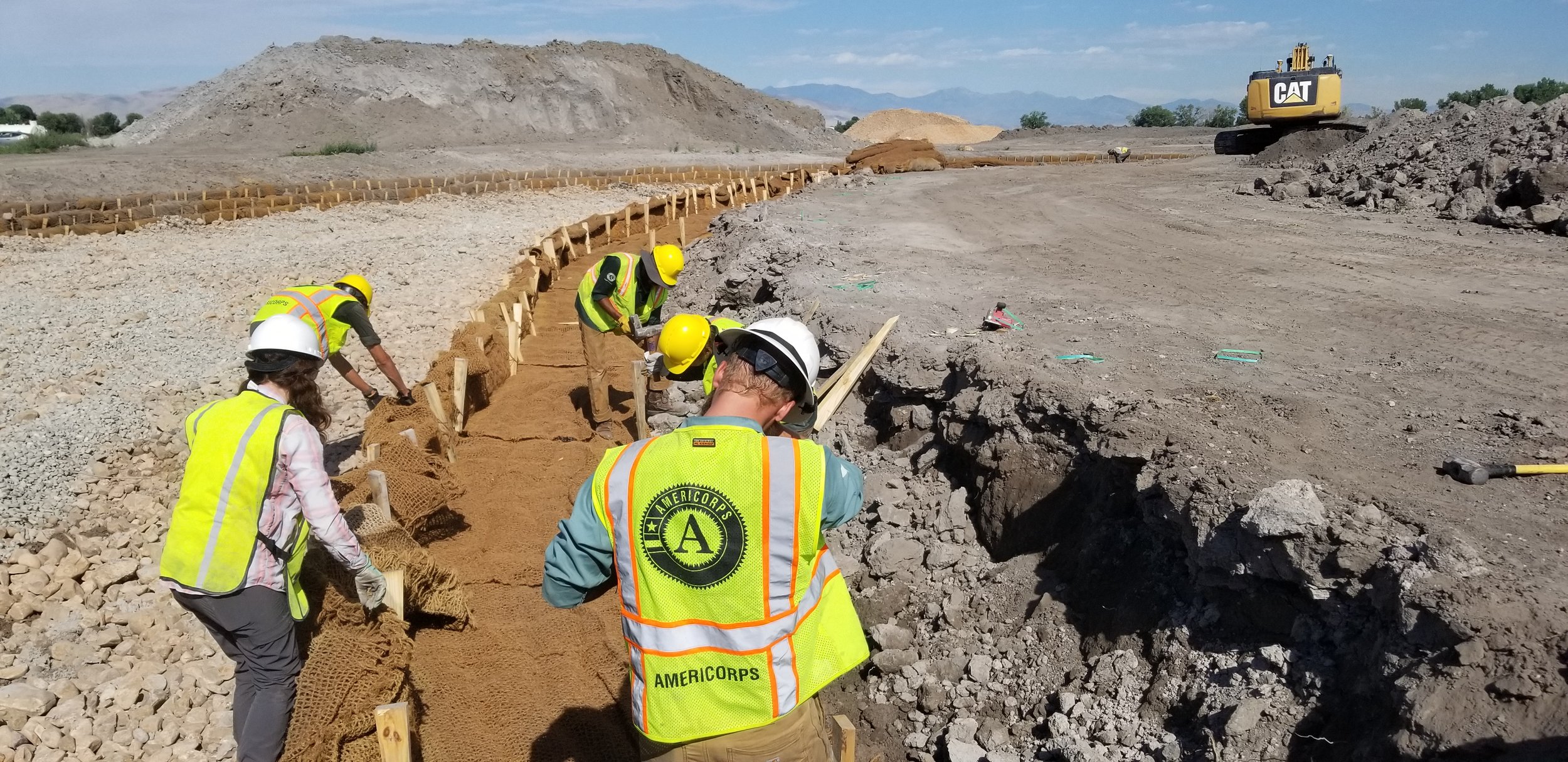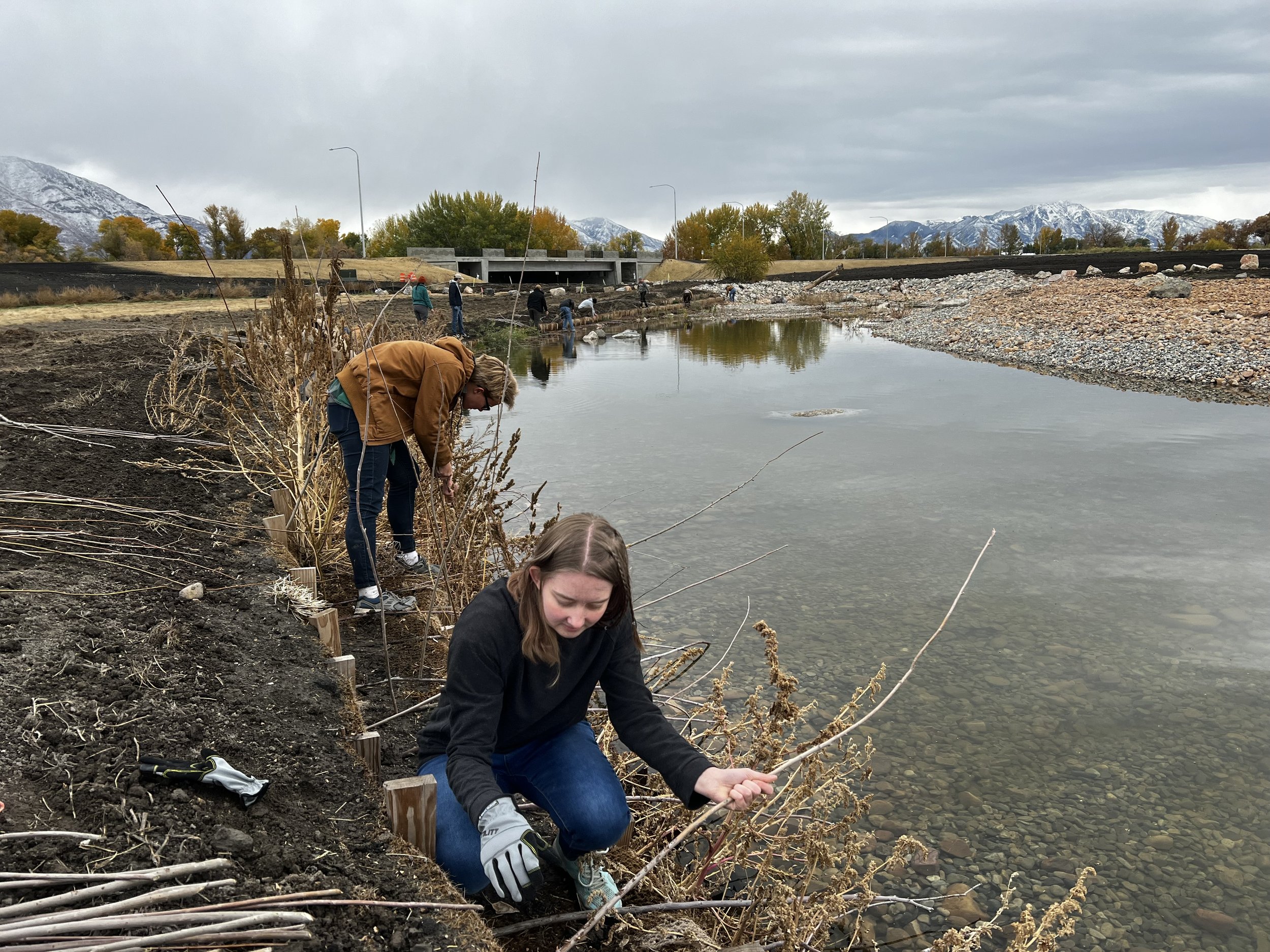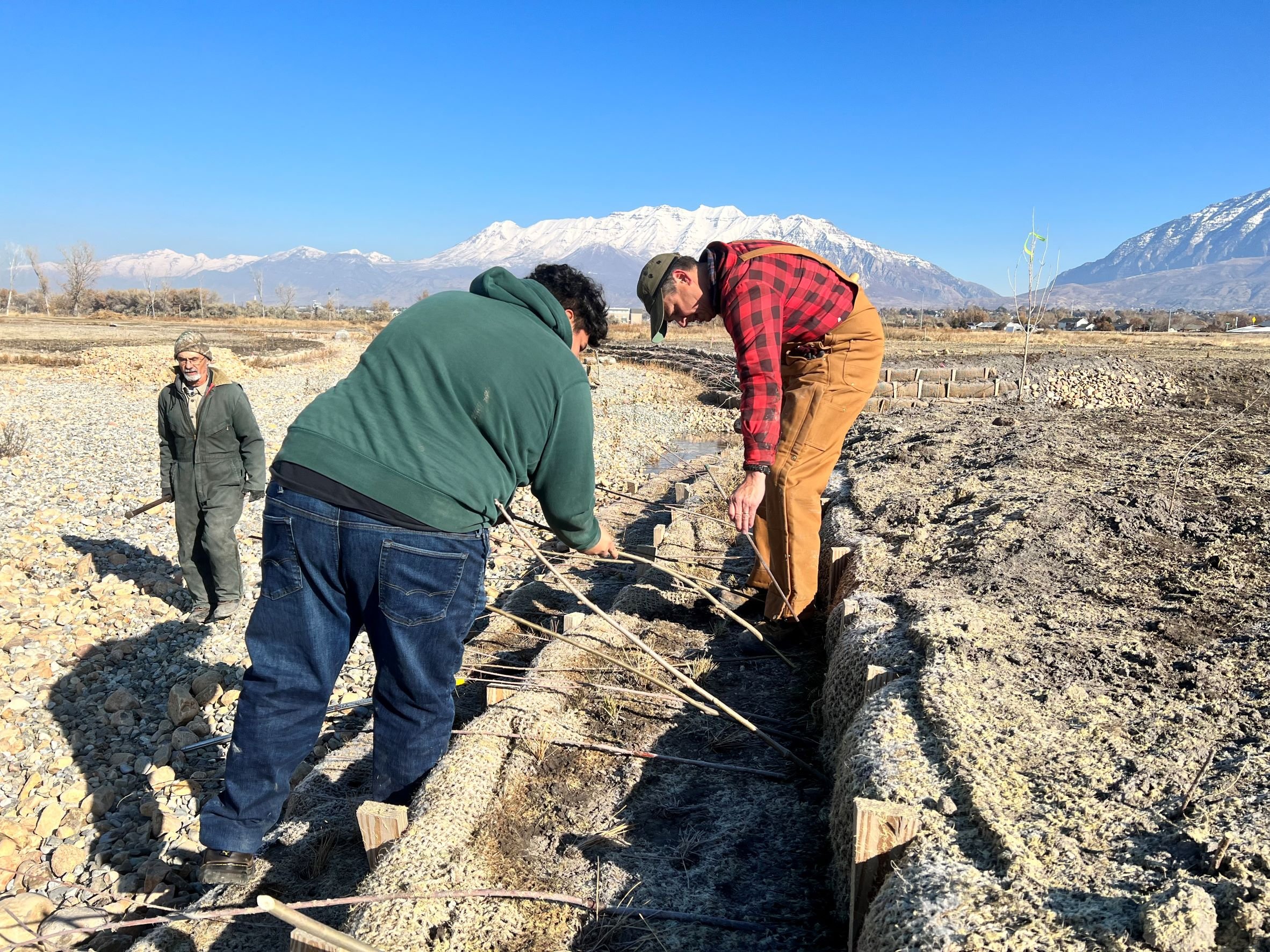Provo River Delta Restoration Project
2022 A Year in Review
New Provo River Channel Construction, Foreground; Existing Channel, Background
Excavation of Delta Habitat Features Nears Completion
The sequence of images below shows construction progress over the last three years
Delta habitat feature excavation was nearly completed in 2022, marking the third year of major construction on the Delta Project. By the close of 2022, we were withing a few hundred feet of tying the newly constructed Provo River Channel into the existing channel. Tying the new delta into the existing channel is a major project milestone. The delta project area will open to the public in late 2024, after construction of new and expanded trails, recreation features and Provo River Delta Gateway Park is complete.
As of December 2022,
13.6 acres of submerged aquatic wetland features have been constructed, seeded, and planted
23 acres of riparian wetland areas have been constructed, seeded, and planted
23,195 feet of river channel has been constructed
Lowering of Skipper Bay Dike
Crews lowered the north half of Skipper Bay Dike, which reconnected historic Skipper Bay to Utah Lake. Skipper Bay was, for thousands of years, a highly productive and biodiverse area teeming with plant and animal life. The bay was effectively cut off from Utah Lake about 100 years ago when Skipper Bay Dike was built and drained for agriculture.
The image to the right shows the Provo Delta Project is being constructed substantially below the Utah Lake meander line as it was originally surveyed in 1856. Without pumping, the Delta Project area is still inundated by groundwater at times as is evident in the February 2020 aerial imagery shown below and in what we are beginning to experience with the heavy precipitation in early 2023.
Constructing Delta’s Riverine Section
Construction on the Provo River Delta transitioned from delta features to riverine features in 2022. Streambanks were constructed using soil wrapped by a coconut fiber blanket material to form and stabilize the new streambanks. The blanket wrapped soil is secured with stakes and planted with willow cuttings placed between and through the coconut fiber. The vegetation will not only help stabilize streambanks with their roots, but will also provide food and habitat for wildlife, filter pollution out of air and water, and help absorb floodwater. These benefits are lost when streambanks are stabilized with more traditional rock riprap or concrete.
Utah Conservation Corps Partnership
For the 3rd straight year we partnered with the Utah Conservation Corps (UCC) to provide on-the-ground field work at the Provo River Delta. This spring and summer, UCC crews helped install coconut fiber soil lifts that form and support the new streambanks and speed up streamside vegetation establishment. Other tasks they tackled include digging out invasive plants like Scotch thistle, tamarisk, and Russian olive, revegetating mounds with local cottonwood and peachleaf willow seeds, and removing old asphalt chunks from the lowered dike.
More UCC crews will be on the project over the coming years, and we will have two AmeriCorps Individual Placement interns working with us while they develop skills that will be valuable for their own careers.
Volunteers Make the Difference
A small army of volunteers helped accomplish many tasks across the delta including planting trees, shrubs, grasses, and pollinator plants, pulling invasive species, and cleaning up trash and debris left by past land uses. We hosted 17 stewardship events where approximately 300 volunteers worked more than 500 hours. Eight public and 17 custom tours were conducted along with 11 tabling events and presentations throughout the community in 2022. We partnered with the nearby Provo High School and other schools to complete stewardship tasks and to use the delta as a massive "outdoor classroom" to learn about how natural processes work and to develop interest in marketable job skills for the future.
We hope some of the students will be life-long stewards, as many of our staff and partners were inspired to work in restoration and conservation related fields by exposure to natural sciences in their youth. Local angling groups, bird watchers, neighbors, trail users, hunters, and others in the community also participated in stewardship events. Our “Second Saturday” tour and volunteer events will resume in April of 2023.
Revegetation
Revegetation efforts have been a key to the success of the project over the entire construction period and will continue over the next few years. After a long, hot and dry summer we were feeling a bit puckered of the bone-dry conditions in the Provo River Delta project area where we were scheduled to take delivery of 75,000 native plants. But the seasons finally changed, the skies darkened, and the clouds opened up just days before the plants were to arrive. Soaking rains and even some early snow provided excellent conditions for the new plants.
Plantings were just one of a three-pronged approach to establish native vegetation in the project area. The Utah Division of Wildlife Resources helped prepare planting areas and seeded disturbed areas with native seed. We also hydromulched (as indicated by the bright green areas in the photo above) in places where we were able to bring in hydromulching equipment. Similar revegetation efforts were completed in 2020 and 2021 and native vegetation is becoming well established in the Delta Project area.
We are also partnering with TreeUtah to provide opportunities for you to help us develop the riparian forests of the future next season!
Willows planted along bank in November 2022
June Sucker Recovery Implementation Program Anniversary
In 2022, the June Sucker Recovery Implementation Program (JSRIP) celebrated its 20-year anniversary and is also celebrating a growing June sucker population. Over the years, the partnership has implemented numerous projects intended to recover the June sucker and improve the Utah Lake ecosystem. Each year, biologists take advantage of the June sucker spawning run to evaluate the status of the population and gauge the effectiveness of recovery actions.
When the JSRIP was started in 2002, 139 adult June sucker were observed in the Provo River spawning run. In 2022, over 5,000 June sucker were recorded with electronic transponders traveling in the Provo River. This tremendous growth in the June sucker population is thanks to the actions of the JSRIP and many partners, and led to the species being upgraded from endangered to threatened status in 2021. With further progress on JSRIP efforts like the Provo River Delta Restoration Project, the hope is that the June sucker will fully recover and eventually be able to be delisted altogether.
Delta Gateway Park Site Preparation
Equipment staging and preparations began in 2022 at the future Provo River Delta Gateway Park on the south side of Provo River near Lakeshore Drive. When complete, the family-friendly park will feature a nature-themed playground for children to enjoy while learning about and engaging with the river and riparian ecosystem surrounding the park. Provo City Parks and Recreation is developing the park with support and funding from the Provo River Delta Project.
Looking Ahead to 2023
2023 is shaping up to be another busy year with work focusing on constructing the many recreation features associated with the Provo River Delta project. In the delta, access to the water will be provided with a non-motorized boat ramp located adjacent to the Skipper Bay Trailhead and parking area. Crews will also be working on the new Skipper Bay berm trail along the south edge of the delta, which will connect the existing Provo River Parkway in a loop back to Lakeshore Bridge Trailhead with both pedestrian and equestrian trails in parallel. Along the Lower Provo River, angling access and non-motorized boat access will be developed at several areas and a downstream dam will pond water up to an elevation that will provide flat water boating opportunities year-round into the future, in addition to a portage providing access to Utah Lake at the State Park. Provo City will also be working on the Delta Gateway Park, which will provide a significant boost to the quality of life and outdoor education opportunities for local students, residents, and visitors.
Trail Closure
Please remember that the entire Provo River Delta Project Area, including the areas along the Utah Lake shoreline, will remain an active construction area closed to public access, including for hunting, until project construction is complete in late 2024.
